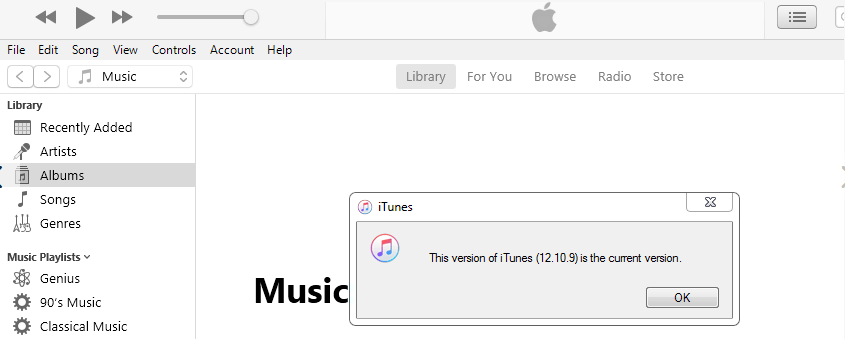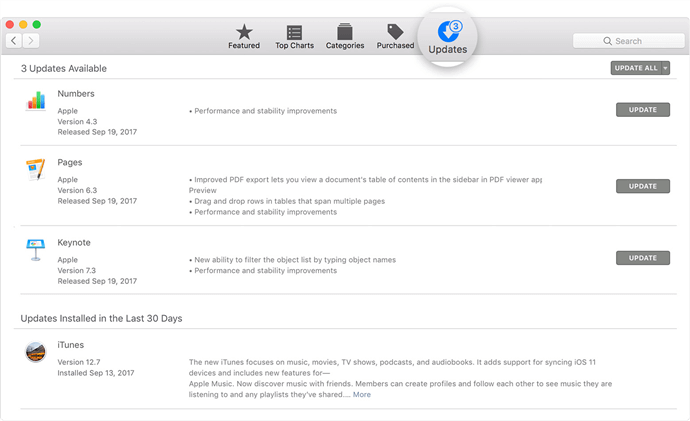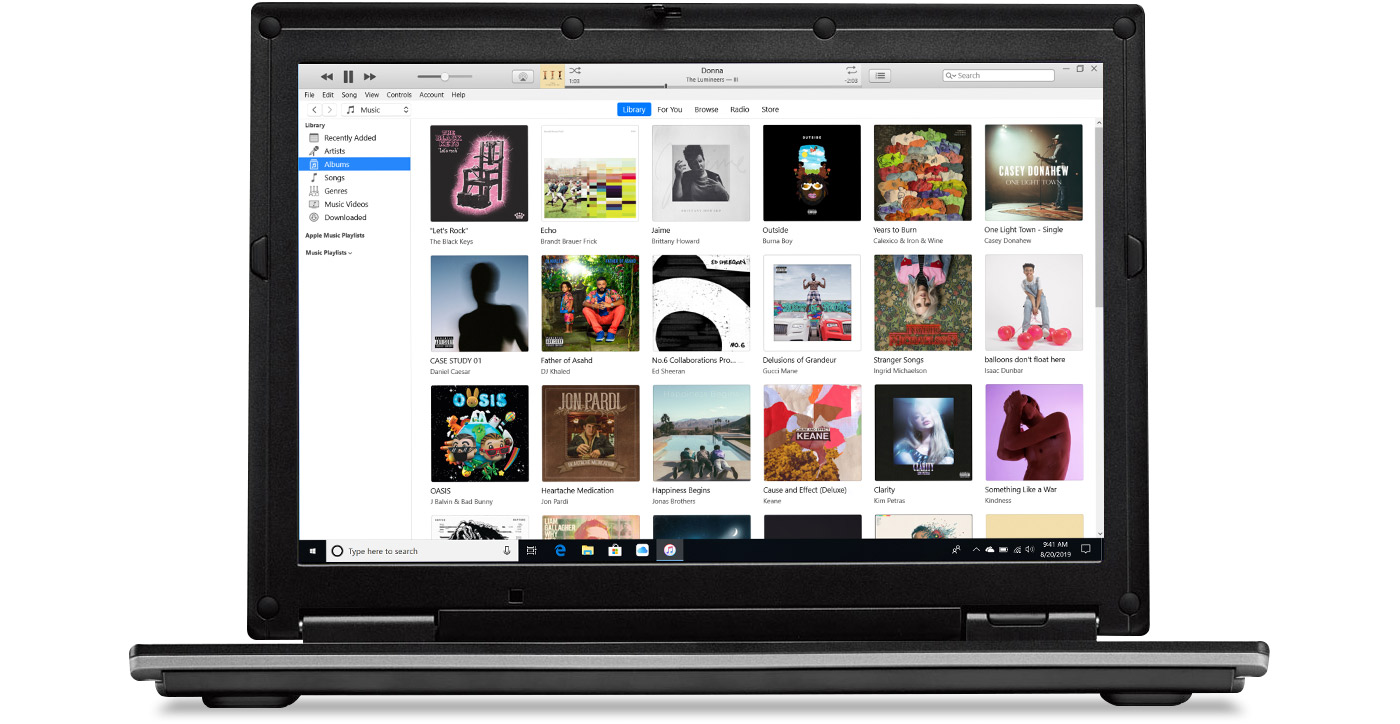What is the latest version of iTunes now in 2019? How can I update my iTunes to the newest version? Read this post get the answer you need.
If you install iTunes from the iTunes Download page, you can manually check for updates to iTunes, or set iTunes to check for new versions automatically every week. In the iTunes app on your PC, do one of the following: Manually check for new versions of iTunes: Choose Help Check for Updates. Have iTunes automatically check for new versions every week: Choose Edit Preferences, click Advanced, then make sure the “Check for new software updates automatically” is selected. Mar 18, 2021 On a Windows PC: Step 1. From the menu bar at the top of the iTunes window, choose Help Check for iTunes Updates. An Apple Software Update window will pop up, and check if iTunes latest version is available and click on.

iTunes Tips & Issues
iTunes Basic Learning
iTunes Music Tips
iTunes Libary Tips
iTunes Connection Issues
Other iTunes Data Issues
iTunes is a free program for Mac and PC and it is nearly the most essential application to manage files on iPhone, iPad, and iPod. In early 2019, Apple has announced that there will be great changes in iTunes. Apple has phased out iTunes on macOS, and iTunes will be divided into three apps – Music, TV, and Podcasts. But Windows users do not need to worry about the change, iTunes will stick with it on Windows.
Since the iOS 14 has been already released in this September, and lots of users have already updated to the new device and the new system. To update to iOS 14 using iTunes on Windows computer, you need to update to the latest iTunes, too. What is the latest iTunes version? iTunes 12.10.9 is the newest one by now in 2020.
In September 2017, iTunes updated to a new iTunes 12.7. It was a great change. This update removes the built-in App Store browser, App Store URLs are no longer handled by iTunes. This update also removes the synchronization of ringtones from iTunes, as well as the management of the local applications. According to Apple, this is all because they want iTunes to focus more on the management of media files, such as transferring music, movies, TV shows, podcasts, and audiobooks.
Itunes Latest Version Number

Even though iTunes got a little bit unfamiliar after iTunes 12.7, it still the fundamental software for every Apple user. If you have bypassed the “iTunes Update Available” notification and don’t know how to update iTunes on your PC or Mac, just follow these easy steps to download and install the latest version of iTunes in few minutes.
Also Read: How to Update to iOS 14 with or without iTunes >
How to Update iTunes on PC or Mac Computer
On a Mac (for macOS Mojave):
If you are using a macOS Mojave, please follow the steps below to update iTunes:
Step 1. Choose System Preferences from the Apple menu, then click Software Update to check for updates.
Step 2. If any updates are available, click the Update Now button to install them. Or click ”More info” to see details about each update and select specific updates to install.
Update iTunes in macOS Mojave
Step 3. When Software Update says that your Mac is up to date, macOS and all of its apps are also up to date. That includes Safari, iTunes, Books, Messages, Mail, Calendar, Photos, and FaceTime.
If you are using an earlier macOS, please follow these steps to update iTunes:
Step 1. Open the App Store app on your Mac.
Step 2. Click Updates in the App Store toolbar.
Step 3. Use the Update buttons to download and install any updates listed.
Step 4. When the App Store shows no more updates, your version of macOS and all of its apps are up to date. That includes Safari, iTunes, iBooks, Messages, Mail, Calendar, Photos, and FaceTime.
On a Windows PC:
Step 1. Open iTunes.
Step 2. From the menu bar at the top of the iTunes window, choose Help > Check for iTunes Updates.
Step 3. An Apple Software Update window will pop up, and check if iTunes latest version is available and click on Install 1 item.
Or you can also download the latest version of iTunes from Apple Website directly, and get it installed on your PC.
Also Read: How Long Does the iOS 14 Update Take >
An iTunes Alternative to Transfer & Manage iOS Data
Although iTunes is an essential tool to manage files on your iDevice, some users feel confused about the interface and it is a little bit hard to manage non-purchased items. Why not give a try on an iTunes Alternative? To give you more control and flexible iOS file management experience is what AnyTrans made for. Check its main features:
AnyTrans – iPhone Files Transfer
- Transfer music between any iDevice and computer (PC or Mac).
- Manage your iTunes library and allow you to sync music to iDevice.
- No harm to iOS content and will not erase the existing data.
- Work well with all iPhone models as well as iOS systems.
Free Download100% Clean & Safe
Free Download100% Clean & Safe
Manage iTunes Library with AnyTrans: you can transfer music, movies, ringtones, and more from iTunes to iDevice without wiping.
Manage iTunes Library with AnyTrans
You can manage up to 25 types of iOS files by exporting, importing, deleting, or backing up those files on your iDevice.
The Bottom Line
This is all about what is the latest version of iTunes and how to update it to the current version. As a necessary software for Apple users, iTunes should be paid more attention to. One coin has two sides, iTunes is not a perfect app. If you want to better manage your iOS files, try AnyTrans to get a brand new experience.
More Related Articles
Product-related questions? Contact Our Support Team to Get Quick Solution >
Install Itunes For Windows 7
On Windows 10, iTunes is that one program that never seems to change with the times. It's a bit sluggish, and often fails to work properly. The Microsoft Store version of iTunes did improve things a bit. Yet it's mostly the same old iTunes served in a different wrapping.
But regardless of iTunes and its various quirks, you must update the program regularly. The latest iTunes updates often contain fixes for the various bugs that seem to crop up frequently.
So let's go through the best possible ways to update both the traditional desktop and the Microsoft Store versions of iTunes.
 Note: Updating iTunes is not a sure-fire way to patch all issues with the program, but it's better than running an outdated version on your computer.
Note: Updating iTunes is not a sure-fire way to patch all issues with the program, but it's better than running an outdated version on your computer.Also on Guiding Tech
How to Change the iTunes Backup Location on Windows 10
Read MoreTraditional Desktop Version
The traditional desktop version of iTunes carries a lion's share of bugs and glitches. Hence, updating it is very important, especially if you are encountering serious issues while using it. These three methods should help you update iTunes to the latest version.
1. Update via iTunes
If you can open iTunes without issues, then updating the program is quite easy. After opening iTunes, open the Help menu, and then click Check for Updates.
That should initiate a scan for updates. If there are any updates available, follow the onscreen instructions to install them.
2. Update via Apple Software Update
If iTunes fails to launch, then you can instead use Apple Software Update to update the program. Apple Software Update is a complementary applet that comes bundled in with iTunes, so it should already be present on your computer.
Start by typing apple software update into the Start menu. Afterward, click Open.
Wait for the program to scan for available updates. If there are any, install them.
Also, make it a point to install updates (if listed within Apple Software Update) for any other Apple-related programs installed on your computer, such as iCloud.
3. Update via iTunes Installer
At times, attempting to update iTunes using the two methods above could fail — iTunes or Apple Software Update can hang while downloading the update files.
If this happens, you can use the iTunes installer instead to update iTunes. Start by downloading the latest version of iTunes from the Apple website.
Download iTunes InstallerNote: The button above points you to a page that always lists the latest version of iTunes. Make sure to specify that you want to download the desktop version by scrolling down — otherwise, you will be prompted to download the Microsoft Store version.After downloading it, simply run the installer and follow the onscreen instructions to install iTunes. That should replace the existing version of iTunes with the latest version of the program.
Also on Guiding Tech
#itunes
Click here to see our itunes articles pageMicrosoft Store Version
The Microsoft Store version of iTunes doesn't throw out as many problems as the desktop version of iTunes. But you must still keep the program updated to ensure that you don't run into any weird issues at the worst of times. These two methods should help you do that.
1. Enable Automatic Microsoft Store Updates
Microsoft Store apps are updated automatically by default. But if automatic updates are disabled on your Windows 10 computer, then here's how to re-enable the functionality for all Microsoft Store apps, including iTunes.
Open the Microsoft Store. Click the three-dot icon to the upper-right corner of the screen, and then click Settings.
On the Settings page that shows up, turn on the switch next to Update Apps Automatically.
All Microsoft Store apps, including iTunes, will then be updated automatically whenever new updates are available.
2. Update iTunes App Manually
If you don't want to enable automatic updates for all Microsoft Store apps (or if automatic app updates fail to work), you can instead choose to update iTunes manually.
To do that, click the three-dot icon to the upper-right corner of the Microsoft Store. On the menu that shows up, click Downloads and Updates.
If there's an update for iTunes listed, click the Update icon next to the listing.
That should prompt the Microsoft Store to update iTunes to its latest version.

Also on Guiding Tech
Why Should You Backup iPhone to iCloud or Computer
Read MoreThat's Not All
Running the latest version of iTunes on your PC is the best way to avoid major bugs and glitches while using the program. But you must not stop at that — you must also make sure to update Windows 10 itself regularly. Doing so will ensure that you run into fewer compatibility issues — mostly driver-related — whenever you connect an iPhone or an iPad.
To update Windows 10, open the Start menu, type Windows Update, and then click Check for Updates. If new updates are available, install them. Just keep in mind that certain Windows 10 updates can take a considerable amount of time (and use up lots of bandwidth) to download and install.
Next up:Don't want to deal with iTunes while chilling out to some music? Here are 3 ways to handle iTunes comfortably.
Itunes Latest Version Wiki
The above article may contain affiliate links which help support Guiding Tech. However, it does not affect our editorial integrity. The content remains unbiased and authentic.Read Next
How to Fix iTunes Is Waiting for Windows Update Error
Itunes Latest Version Windows
Receiving an '
